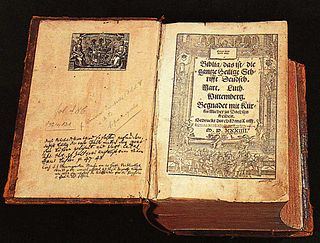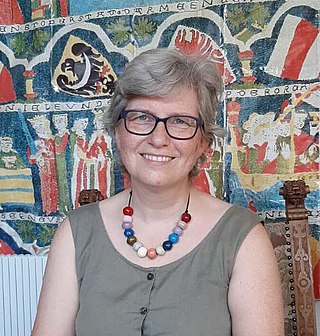
The Luther Bible is a German language Bible translation by the Protestant reformer Martin Luther. A New Testament translation by Luther was first published in September 1522, and the completed Bible, containing a translation of the Old and New Testaments with Apocrypha, in 1534. Luther continued to make improvements to the text until 1545. It was the first full translation of the Bible into German that made use of Greek texts, not just their Latin Vulgate translations.

There have been many Coptic versions of the Bible, including some of the earliest translations into any language. Several different versions were made in the ancient world, with different editions of the Old and New Testament in five of the dialects of Coptic: Bohairic (northern), Fayyumic, Sahidic (southern), Akhmimic and Mesokemic (middle). Biblical books were translated from the Alexandrian Greek version.

Minuscule 33, δ 48 (Soden), before the French Revolution was called Codex Colbertinus 2844. It is a Greek minuscule manuscript of the New Testament on parchment, dated palaeographically to the 9th century. The manuscript is lacunose. It has marginalia. According to the textual critics it is one of the best minuscule manuscripts of the New Testament.

Minuscule 3, δ 253, is a Greek minuscule manuscript of the New Testament, written on vellum. Using the study of comparative writing styles (palaeography), it has been dated to the 12th century. It was one of the manuscripts used by biblical scholar Desiderius Erasmus Roterodamus in his edition of the Greek text of the New Testament.

Minuscule 4, ε 371, is a Greek minuscule manuscript of the New Testament, written on vellum. Using the study of comparative writing styles (palaeography), it has been dated to the 13th century. It was formerly named Codex Regius 84. It has a full collection of marginal marks. It was adapted for liturgical use.

Minuscule 579, ε 376, is a Greek minuscule manuscript of the New Testament Gospels, written on parchment. Using the study of comparative writing styles (palaeography), it has been dated to the 13th century. It was formerly labelled as 80e. The manuscript has some missing portions of text.
Minuscule 152, ε 303 (Soden), is a Greek minuscule manuscript of the New Testament, on parchment leaves. Palaeographically it has been assigned to the 13th century. It has complex contents, and full marginalia.
Minuscule 199, ε 1254 (Soden), is a Greek minuscule manuscript of the New Testament, on parchment. Palaeographically it has been assigned to the 12th century. It has complex contents and full marginalia.
Minuscule 241, δ 507 (Soden), is a Greek minuscule manuscript of the New Testament, on parchment. Palaeographically it has been assigned to the 11th century. Formerly it was labelled by 241e, 104a, 120p, and 47r.
Minuscule 263, δ 372 (Soden), is a Greek minuscule manuscript of the New Testament, on parchment. Paleographically it has been assigned to the 13th century. It has marginalia.
Minuscule 303, Θε32 (Soden), is a Greek minuscule manuscript of the New Testament, on cotton paper. It is dated by a colophon to the year 1255.
Minuscule 399, ε94, is a Greek minuscule manuscript of the New Testament, on parchment. Paleographically it has been assigned to the 9th or 10th century.

Minuscule 459, α 104, is a Greek minuscule manuscript of the New Testament, on parchment. It is dated by a colophon to the year 1092. Formerly it was labeled by 89a and 99p.

Minuscule 473, α1390, is a Greek minuscule manuscript of the New Testament, made from parchment. Using the study of comparative writing styles (palaeography), it has been assigned to the 11th century. Biblical scholar Frederick H. A. Scrivener described it as "one of the most splendid manuscripts extant" which contained "many remarkable variations", and labelled it by the number 512. It has liturgical books and full marginal notes.
The Codex Zittaviensis, δ 502, dedicated as Rahlfs 44, is a Greek minuscule manuscript of the Old Testament and New Testament, on paper. Palaeographically it has been assigned to the 15th century. The manuscript has complex contents. Gregory labelled it by 664e, 253a, 303p, and 106r. Scrivener labelled it by 605e, 233a, 243p, and 106r.
Codex Copticus Tischendorfianus I is a Coptic uncial manuscript of the four Gospels, dated palaeographically to the 10th or 11th century. Originally it contained the text of the four Gospels. It is written in Sahidic dialect of Coptic language. It is classified on the list of Coptic manuscripts of the New Testament on the position sa 181. The manuscript has survived in a fragmentary condition.
The Jüngere Hochmeisterchronik, Croniken van der Duytscher Oirden, or Utrecht Chronicle of the Teutonic Order is a Middle Dutch chronicle of the Teutonic Order. It was written in or around the city of Utrecht in the Low Countries in several phases: around 1480, around 1491, and with some minor alterations after 1492. It has been referred to as “the final piece of the puzzle that is the official historiographic tradition of the Teutonic Order”. The anonymous chronicle was likely authored by the land commander of the Utrecht bailiwick of the Teutonic Order, Johan van Drongelen, in cooperation with his personal secretary Hendrik Gerardsz. van Vianen.
Minuscule 918, O 66, is a 16th-century Greek minuscule manuscript of the New Testament on paper, with a commentary. The manuscript is famous for the Comma Johanneum.

Henrike Lähnemann is a German medievalist and holds the Chair of Medieval German, University of Oxford. She is a Fellow of St Edmund Hall, Oxford.








